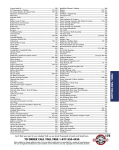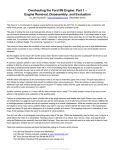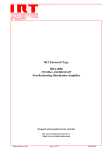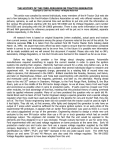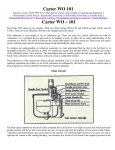Download Cleaning Marvel Schebler carburetors used on Ford N Series Tractors
Transcript
Cleaning Marvel Schebler carburetors used on Ford N Series Tractors Shut the fuel valve off on the bottom of the fuel tank. Remove carburetor from the Tractor by disconnecting the 2 linkage rods, air tube, and fuel line. The fuel line will be full of gas. Remove any gasket material from the bottom of the intake manifold. (note I use an additional fuel shutoff on my carbs). Remove the idle mixture screw/spring, power jet needle/spring, and fuel strainer elbow. Remove the 4 body screws and carefully separate the body halves. Remove the float by pulling the small pin out. Gently shake the float and listen for liquid. If any is heard replace the float. After removing the float remove the 3 sided float needle and venturi. Remove the float valve seat. Note the modified screw driver I'm using. The seat is easily damaged if the screwdriver does not engage the seat fully. This was an inexpensive screwdriver that was ground down to fit the seats. Note the carb top is in a vice with a towel so as to not damage the casting. Keep pressure on the screwdriver to keep it engaged in the seat. Remove the idle jet. Use a screw driver with the widest blade that will fit. Keep the blade seated firmly in the jet when removing to avoid twisting the top off. Remove the economizer jet using the widest screwdriver that will fit. I have ground the sides off a couple screwdrivers who tips fit. Many screwdriver shanks are wider than the tip. Keep the blade seated firmly in the jet when removing to avoid twisting the top off. Remove the throttle butterfly by removing the 2 screws. Note the orientation of the butterfly. With the butterfly out, gently pull the throttle shaft out the side of the casting. Note how much play the shaft has up and down. The bore can wear in the casting which can be re-bushed and the throttle shafts wear which can be replaced. Remove the throttle shaft seal and seal retainer. Here you can see the seal behind the retainer. The retainer is a light press fit and can be removed by gently prying behind it and working around the casting. Here the throttle shaft seal and retainer are removed. Note that this carburetor has had a bushing installed in the throttle shaft bore. This is a common repair and the bushing is available from the usual sources. Remove the front hole plug. This hole was used in the manufacturing process only and we will use it to gain access to the small dia holes in the upper carburetor bore. It may be necessary to back out the stud bolt to gain access to the plug. Mount the lower casting in the vice. Remove the main nozzle. I use a 3/8 nut driver. Remove the main jet using the widest screwdriver that will fit. I have ground the sides off a couple screwdrivers who tips fit. Many screwdriver shanks are wider than the tip. Keep the blade seated firmly in the jet when removing to avoid twisting the top off. Remove the plug on the bottom of the carburetor. This plug is used to diagnose fuel flow problems but the area is frequently plugged with rust making the test result misleading. These passages lead to the inside of the fuel bowl. Open them with a piece of wire. This is a choke butterfly installed backwards. If you see this you need to remove the choke plate and shaft. Unless you have this problem or have a leaking choke packing I recommend not removing the choke plate. This is properly installed choke plate. Again I wouldn't remove it unless necessary. Scrape any remaining gasket material off being careful not to gouge the castings. Place the 2 castings in a gallon of carburetor cleaner and allow to soak. If the carb hasn't been cleaned in years you may want to soak it for a couple of days. This carb was cleaned recently but wasn't idling right. I soaked it overnight. This is a place for safety glasses and rubber gloves. While your castings are soaking inspect all the parts. Replace any worn or damaged parts. I usually only replace parts that are worn or damaged. If you don't know the history of the carb or its in bad shape it may be advisable to order a full kit. Remove the parts from the carburetor cleaner. While the casting is still wet and using the information documented by GB_ MT and JMOR run a wire through all the passages. I use guitar strings. I can always get a wire through the top hole shown. I can sometimes get a wire through the lower hole as it does a tight turn. Not shown is the hole to the side which is part of the economizer circuit which I can't always get a wire through either but will be visible if the casting is turned over and you look in the hole for the economizer jet. Do the same to the lower casting. Clean the castings using your favorite canned quick drying solvent. Use the front access hole to spray cleaner in each of the holes ensuring the solvent is exiting a different hole. Here the tube is being directed to the economizer circuit. This is another place for Safety glasses and gloves. Follow-up with compressed air directed to all the passages. Your castings may still have some residue on them. I use a Dremel tool with small wire wheels to clean my castings. After cleaning your castings, run the wire through all the passages again. After cleaning and running the wire through the passages, clean them again with compressed solvent and follow-up with compressed air directed to all the passages. Run a fine mill file lightly across the mating surfaces to remove any burrs only. Check to see if the castings mate. There are many carbs out there and the halves may have been swapped or the castings could be damaged or warped. While you may be able to double gasket the carb the dimensions for the venturi are dependent on 1 gasket being used. Using the info provided by GB in MT verify the orifice size on your Jets. You can use number drills, or welder tip cleaners with a MIC or any way you can. There are simply too many jets out there to assume yours are correct. I used a set of welder tip cleaners and very small drill bits finding the ones that fit then mic'd them. Install the main jet. Use the widest screwdriver that will fit and snug the jet in but don't over tighten. Note the camera has a way of bringing out reds and the casting appears rusted in the photo, it's actually much cleaner in person. Install the plug on the bottom of the carb. Clean the small holes in the main nozzle. There should be 3. There are other nozzles out there that fit that have different hole arrangements. Install the nozzle using a gasket under the hex head. (picture from teardown) Install the throttle shaft seal lips in, install the retainer which is a light (very) press fit. I always use a new shaft seal. Install the front plug that was used for access to the small holes in the throat. Check the fuel needle valve. It may be viton (rubber) tipped or just steel. Either is acceptable. Observe the hole in the seat for burrs. Check to see that the needle moves in the seat without burrs or snags. Install the float valve seat and gasket. Use a screwdriver that fits (modified) and tighten securely. Fuel leaking around this seat can cause other problems. Install the idle jet Install the economizer jet. Install the throttle shaft and butterfly. If you've lost the orientation of the butterfly it's easy to determine the orientation. The edges are not machined square and if you observe how it opens it won't take long to see how it should fit plus the screw holes are slightly off center. I rotate the shaft as I tighten the screws down getting the butterfly to center/seat in the opening. Install the fuel needle, body gasket, and float. Check the float height. I use a 1/4" dia drill bit as a gauge. Here the float height is set properly as the float just touches the drill bit. If needed gently bend the float as shown. I set my float parallel to the casting which can be a subject of discussion. I do this as its shown in the MS service manual Remove the float and install the venturi. It only fits one way and if you check you will see that one end is larger than the other. Run the small end through a new body gasket and reinstall the float. Don't forget to verify the float needle valve is still in. Mate the two halves and install the 4 body screws. I wiggle to 2 castings in an attempt to get them to center over the 4 screws. Just before the 4 screws are tightened I verify that the power jet needle can be installed fully which requires the castings to be aligned. Once checked back it out and fully tighten the 4 screws. A test to check that the float is not binding is to gently turn the carb upside down them back up and listen for the float. You should be able hear it as it hits its travel limits. Install the power jet needle/spring/gasket and run it in untill it bottoms out. Back the screw out 1.5 turns. Install the idle mix needle/spring and run it in untill it bottoms out. Back the screw out .75 turns. Install the fuel strainer and install the completed carb on the tractor. If completed as shown and the tractor is in good general shape it will start on these settings once the fuel bowl receives gas. Warm the tractor up and adjust as follows: Adjust the idle mix for smoothest operation. Backing the screw out leans the mix and with a lean mix the tractor will begin to "pop" in the exhaust. Running too rich will produce a somewhat more constant labored "bub-bub-bub" sound. My idle mix needles are usually adjusted around .5 turns out. Adjust the idle screw (on the throttle shaft) for idle rpm which the manual says is 400 rpm. Unless you have a tractormeter or other gear you will not know where 400 rpm is but its slower than your car. I don't get to worried about the actual RPM and just adjust for a slow smooth idle. The power jet is checked by quickly opening the throttle. If the tractor stumbles, open (back out) the needle a little more. If the motor responds well but produces a sooty exhaust the mix is too rich and the valve can be run in a little. Only move the needle in 1/8 turn increments and adjusting the power jet can affect the idle jet setting. Backing the needle out enriches the mix. Adjust the carb then operate the tractor under a load. Only make small adjustments and then run the tractor some more. It may be necessary to complete this sequence 2 or 3 times to dial in the settings. www.johnsoldiron.com July 2010





















